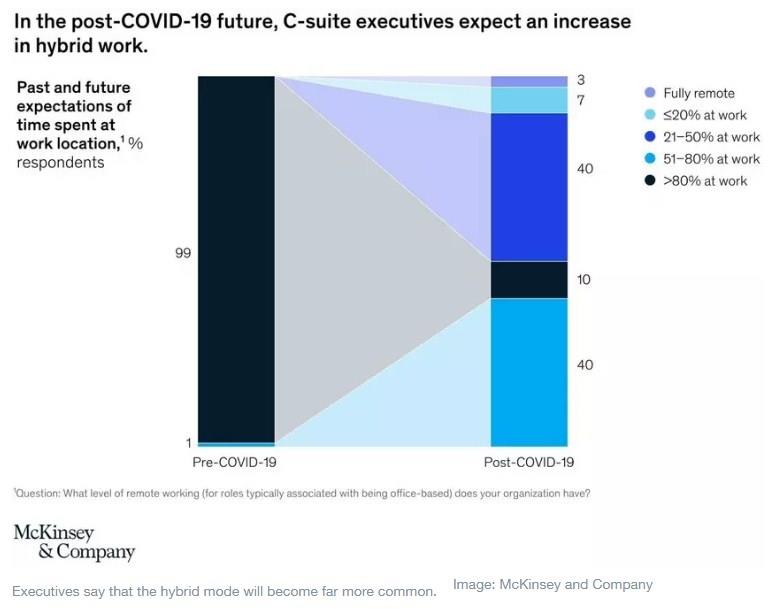by Ben Crawford*
When I last wrote about pandemic-prompted digital transformation, I ended with some thoughts about the future of remote work and its potential for economic growth, job creation and increased prosperity. Since then, Gartner has estimated that remote workers will make up around 30% of the global workforce by the end of this year, and as much as half of all knowledge workers will be working remotely as we head into 2022.

Those numbers speak to significant shifts in where, when, how and even why we work. But even with these shifts, home-based work has not completely overwritten the need for some form of office space and the resources available in these spaces, as well as the in-person potential for productive brainstorming and spontaneous innovation that can be challenging to simulate and stimulate online.
Hybrid is the new standard.
A hybrid model is being pointed to as an effective trade-off and way to avoid issues such as digital burnout that currently weighs on the mental health and productivity of much of the remote workforce. The story of Zoom’s CEO acknowledging his own Zoom fatigue and planning a hybrid model for his company is telling. I think it is clear that a hybrid or productivity anywhere model should be the new standard for digital-first businesses to adopt.
And I can personally testify to the power of the productivity anywhere model as I have lived it myself for many years. As virtual-forward teams become more common and global in scope, the factors that have powered my own productivity anywhere lifestyle — which includes informed yet versatile guidelines and an emphasis on collaboration — can be utilized by firms to build a thriving and resilient hybrid culture.
Central to this culture-building is a clearly defined yet adaptable vision for the future of work, coupled with tech investments that support clear communication and the easing of common virtual hurdles. Overall, all hybrid models should be driven by strategic business objectives and personnel concerns that extend to employee mental health and overall well-being. While we must acknowledge that the shift towards these new forms of investment and culture-building will be an ongoing process, it is one that leaders should be diving into headfirst.
Productive growth is growth for all.
Productivity has been widely discussed in the news since the onset of the pandemic. While many early studies showed a strong correlation between remote work and increased worker productivity, more recent ones have produced varied results alongside novel factors like “panic productivity” and the inability to log off. I do not think this form of productivity is sustainable or even desirable in the longer term. It may also exacerbate the global tech talent shortage currently holding back the development of a more robust and diverse digital economy.
On the employee side, some factors that have consistently boosted both productivity and job satisfaction, factors which I am actively utilizing as a part of my company’s hybrid working model roll-out, include clear and compassionate messaging from leadership; investment in solid tech infrastructure; automation for processes like onboarding; proper remote management training for team leaders; and policies that support case-by-case employee hurdles and concerns.
On the customer side of the coin, omnichannel development that empowers users to build all-encompassing digital business frameworks is an area ripe for exploration and expansion. While many digital firms can benefit from an omnichannel approach, it is especially useful for companies that strive to provide tools and support for individuals and organizations looking to digitize, expand and protect their brands online.
Elsewhere, tech investment in many other efficiency-boosting sectors, such as AI and automation, is projected to skyrocket in the coming years. However, all of this productivity potential will be trapped in an unproductive fog if there is no digital literacy and reliable internet connectivity for all. There is enormous work to be done in both developing and advanced economies as connectivity issues and a lack of investment in both STEM education and worker upskilling continue to hold back the global development of a highly mobile digital workforce.
Telecommunications services and governments must continue to invest in reliable internet infrastructure and digital skilling if we’re to enjoy the widespread economic productivity that can result from the tech investment and trends taking shape worldwide. Further, high-performing digital businesses must focus on supporting change throughout their supply chains and bolstering SMBs so that smaller companies may grow at a similar rate and share in digital gains.
When adequate infrastructure and public-private collaboration are in place, hybrid work can undoubtedly foster a much more productive, diverse and inclusive workforce as demographics previously excluded from office-based work can apply their talents to the digital economy.
Keep well-being in focus.
The past 18 months have been an incredible time of new digitally mediated connections amidst the suffering and isolation, both within our private communities and workplaces. However, well-being has undoubtedly been affected by the global situation and the new ways we have been forced to connect and work together.
The most proactive and productive organizations have taken time to listen, react and provide resources that support long-term employee wellness, such as mental health assistance programs and financial security courses. Further, organizations that have articulated a clearly defined vision for the future of work have seen employee well-being and productivity rise. This last point confirms what many of us have long intuited —and which David Michels and Kevin Murphy’s recent Harvard Business Review paper revealed — that the most profitable companies tend to be the most adaptable to change.
Employers and employees alike are querying what we do at work and how we do it, with creativity and empathy being central to increasing company-wide resilience and gain. For people- and data-driven organizations committed to global digital inclusion and a better digital economy, it is time to keep listening, planning, transforming, diversifying and experimenting if we are to write a better future workplace into the history books.
*CEO, CentralNic
**first published in: www.weforum.org




 By: N. Peter Kramer
By: N. Peter Kramer

